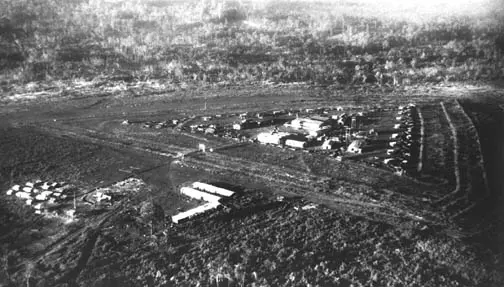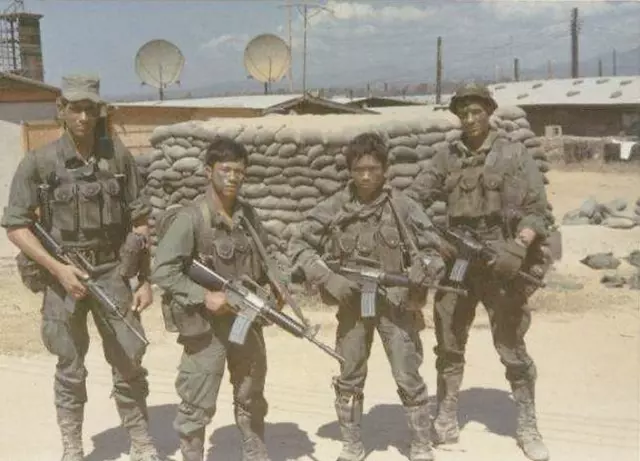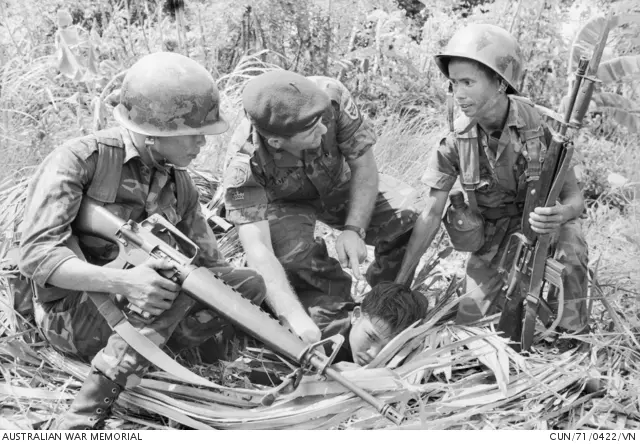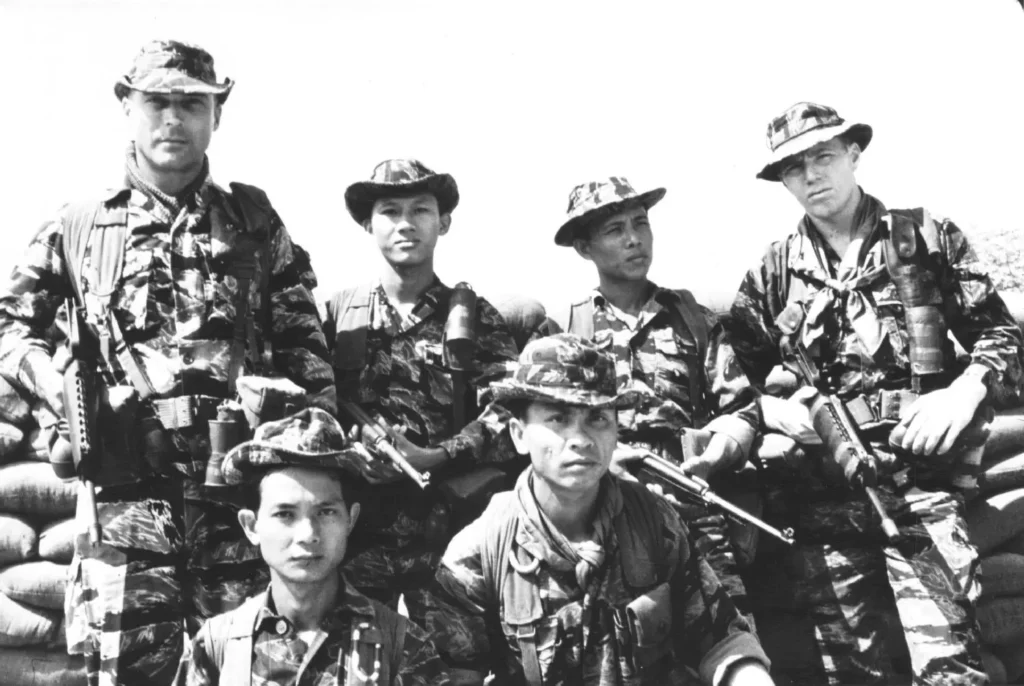In 1965, the scope of the Vietnam War was changing. The United States was moving from an advisory role to large combat formations in-country. It was only a matter of time before large troop concentrations faced each other in battle.
Most of us are well familiar with the first large battle between American and North Vietnamese troops in the Ia Drang Valley, with LTC Hal Moore’s 7th Cavalry becoming a book and a major motion picture, We Were Soldiers Once.
But what set the stage for that pivotal battle, was the siege of the Special Forces camp at Plei Me. The siege took place between October 19-25, 1965, at an isolated Special Forces “A-Camp” at Plei Me, which was located 25 miles south of Pleiku and about 20 miles from the Cambodian border in the Central Highlands.
The Green Berets build a medieval fort

The Green Berets initially settled the camp in Plei Me in 1963, as they set up many camps in the Central Highlands in an attempt to interdict Communist infiltration routes from Cambodia along the Ho Chi Minh Trail. The Special Forces troops had gone about gaining the trust of the Montagnard indigenous people, and they recruited them to be the “strikers” of the camp, as part of the Civilian Irregular Defense Group (CIDG).
In 1965, the camp in Plei Me, also known as A-255, was commanded by Captain Harold Moore, whose 12-man Special Forces A-Team had 400 CIDG strikers — local Montagnard irregulars of the Jarai tribe and 14 South Vietnamese Special Forces troops. The triangle-shaped camp resembled a medieval fort with trenches, palisades, modern razor wire, and gun emplacements.
Brigadier General Chu Huy Man commanded the North Vietnamese Army troops. His plan was not to take the camp at Plei Me at once, but to threaten it in order to bring out a South Vietnamese relief force, ambush and destroy it, then take the camp at Plei Me, before moving on to capture Pleiku and the other Special Forces camps in the Central Highlands. He had the 32nd and 33rd Regiments under his control, about 4,200 men-strong, with another regiment, the 66th, comprised of another 2,000 men being transferred to him in early November.
Related: More than missing guns: Why America lost dogfights over Vietnam
The battle of Plei Me begins

The plan was for the NVA troops not to allow the Americans to know about the attack until it was too late. The CIDG troops were patrolling farther out, but they weren’t watching close by the camp, so the North Vietnamene successfully infiltrated without being detected.
General Man didn’t want to wait for the 66th to become available because the American 1st Cavalry Division was getting prepared to conduct combat operations. And he wanted to act before the Americans were ready.
Things began at about 1900 hours on October 19 with NVA troops ambushing a CIDG patrol. Three hours later, an NVA company overran a Montagnard outpost. Shortly after midnight, all hell broke loose. NVA troops attacked from the north, east, and west, firing mortars, recoilless rifles, and small arms.
The attack reached the defensive perimeter in one spot, forcing the defenders back to the next level of their defenses. CPT Moore called in airstrikes which continued all throughout next day and into the night of October 20. The Green Berets would later say that the A1E Skyraider attacks were constant, as they were almost linked tail to nose.
According to after-action report by the Army, “Air power played a key role in breaking the attack for the next ten days. In 696 day and night strike sorties, The Air Force dropped 250,380 pounds of frag bombs, 485,880 pounds of napalm, plus rockets, CBUs, and cannon fire on NVA/VC positions as close as 35 meters from the outpost walls.”
However, the ground fire from the NVA was intense. Two B-57 bombers were hit, with one crashing; four C-123 flare ships were also hit.
Related: Secret mission to Kabul: The C-17 that helped launch the Afghan airlift
Major Beckwith arrives and the relief column is ambushed

While the South Vietnamese were preparing a relief column, SF Major Charles Beckwith airlifted 175 South Vietnamese (ARVN) Rangers three miles outside the camp. They reached the camp on the morning of October 21, and Beckwith assumed command of the camp.
Beckwith was ordered to counterattack with his ARVN Rangers, but they were quickly beaten back with heavy casualties and pulled back into the camp.
On October 23, the relief column of ARVN soldiers was ambushed but it managed to beat back the ambushes with the assistance of U.S. airstrikes. The NVA pulled back, despite causing heavy casualties to the ARVN troops.
The airstrikes around the camp finally broke the back of the siege, and the Plei Me camp was saved. The Air Cavalry troops moved in, and General Westmoreland ordered them to pursue the retreating NVA forces.
When it was over, North Vietnam had lost 326 killed men, and the camp’s defenders estimated that up to another 700 dead had been carried off, according to the Army’s report.
This was the war’s largest close air support operation up to that point. An excellent book to read on the battle is Death in the Highlands: The Siege of Special Forces Camp Plei Me by J. Keith Saliba.
Two weeks later, Hal Moore’s 7th Cavalry headed into the Ia Drang Valley.
Major Beckwith got a call from President Johnson congratulating him on his defense of the camp. Major Charlie Beckwith would later become the first commander of the Army’s Delta Force.
Steve Balestrieri is a proven military analyst. He served as a US Army Special Forces NCO and Warrant Officer in the 7th Special Forces Group. In addition to writing for Sandboxx.com, he has written for 19fortyfive.com and SOFREP.com; he has covered the NFL for PatsFans.com for over 11 years. His work was regularly featured in the Millbury-Sutton Chronicle and Grafton News newspapers in Massachusetts.
Feature Image: Green Berets and South Vietnamese Rangers in 1968. (United States Army Heritage and Education Center)
Read more from Sandboxx News
- How the Vietnam War changed the Navy SEALs forever
- Operation Junction City: Vietnam’s only large-scale airborne operation
- Cowboy: A legendary commando in America’s secret war in Vietnam
- This is the fascinating history of grenadiers, a centuries-old elite unit
- Battle priests – These are the 5 most famous holy men at war



